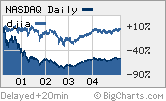 |
| The Dow has bounced back in the past five years but tech stocks are still way off their all-time highs. |
|
|
|
| �* for past five years through 2/28/05 | | �Source:��Thomson/Baseline |
|
|
|
|
NEW YORK (CNN/Money) � Can you believe it's been five years? Yup. It was March 2000 when the Nasdaq surpassed the 5K mark and tech stock fans everywhere rejoiced.
Investors were getting rich off of shares of unprofitable dot-coms, networking equipment firms and software companies. It was a glorious time.
So the quinquennial (what a cool word!) of Nasdaq 5000 is finally here. And in case you're wondering, the traditional gift for a fifth anniversary is something made of wood.
That's only fitting since many tech investors must feel like they've been getting caned during the past five years. The Nasdaq is now hovering around 2000, about 60 percent below the all-time high set on March 10, 2000.
And the pain is particularly acute for long-time shareholders of companies like Sun Microsystems, Gateway, Lucent, PMC-Sierra, Ciena and JDS Uniphase. Each stock has plummeted more than 90 percent during the past five years.
When techs were kings
Oh, how the times have changed. Web hosting firms are no longer bellwethers of tech demand. You don't hear a whole lot about B2B firms anymore either. And that Pets.com sock puppet is now hawking (or is it barking?) for 1-800-Barnone, a subprime auto lender.
But fortunately, the biggest difference between now and five years ago is that most tech stocks are not nearly as ridiculously priced as they were in 2000. For longer-term investors, now is actually a good time to be taking a look at tech leaders.
Let's take a quick stroll down valuation memory lane.
Cisco Systems (Research) traded at more than 150 times 2000 earnings estimates back in March 2000 and now, it trades for just 19 times earnings. Oracle (Research) was valued at nearly 125 times 2000 earnings projections. Now it has a P/E of 21. Microsoft (Research) then? A P/E of more than 60. Microsoft now? A P/E of just 20.
The tech companies in the S&P 500 now trade for 28 times earnings estimates for this year. Five years ago, these companies were trading at 91 times 2000 earnings estimates.
Of course, many of these large cap techs aren't expected to post supersized growth rates any more either, which is the main reason for this multiple compression. Five years ago, analysts expected Cisco's earnings to increase at a 30 percent clip for the next five years. Now analysts are projecting a far more staid long-term growth rate of 15 percent.
Analysts had pegged the growth rates for Oracle and Microsoft at 25 percent in 2000. Now the companies are expected to post earnings increases of just 10 percent and 11 percent respectively.
But Cisco, Oracle and Microsoft are just three examples of techs that may have reached maturity. There still are ample growth opportunities in the sector.
New leaders and old favorites
Yahoo! (Research) is expected to post an average earnings increase of 30 percent a year for the next five years, for example. The estimated long-term growth rate for contract manufacturing firm Jabil Circuit (Research) is a healthy 25 percent. Dell (Research) and Qualcomm (Research) both have long-term growth rates pegged at 20 percent.
Investors might also want to take a look at companies that have actually emerged from the tech storm in a better position than they were in five years ago. It may seem hard to believe but twelve of the 81 tech stocks in the S&P 500 are trading higher now than they were at the beginning of March 2000.
Tech services firms Affiliated Computer Services (Research), First Data (Research) and Fiserv (Research) have all enjoyed sizable gains in the past five years but each stock trades at just 17 times 2005 earnings estimates. First Data's earnings are expected to increase at a 15 percent clip while analysts are projecting long-term growth rates in excess of 16 percent for ACS and Fiserv.
Then there's Symantec (Research), the leading maker of security software. A series of worms and virus attacks during the past five years has helped propel strong gains in sales and profits for the company.
Shares have come under pressure lately due to concerns about increased competition from Microsoft as well as skepticism about the company's merger with storage software developer Veritas. But at 25 times earnings estimates and with an 18 percent long-term growth rate, the stock looks attractive.
Finally, there's Electronic Arts (Research). Still the undisputed heavyweight champion of the video game software industry, the stock isn't cheap, trading at 34 times earnings estimates. But with a long-term growth rate of 19 percent, it will probably keep knocking out the competition just like Maggie Fitzgerald did in "Million Dollar Baby."
Which reminds me. The more some things have changed since March 2000, the more some stay the same. Hilary Swank beat out Annette Benning to win the Best Actress Oscar five years ago too.
Sign up to receive the Tech Investor column by e-mail.
Plus, see more tech commentary and get the latest tech news.

|